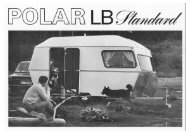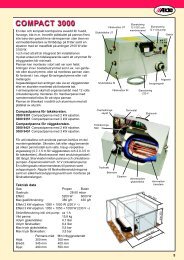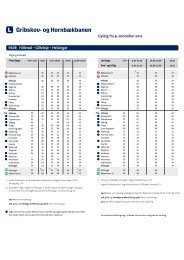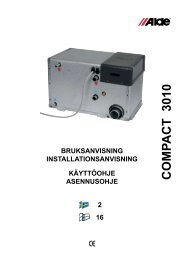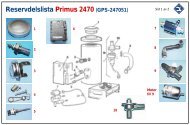bruk 2928.indd - Norrlandsvagnar
bruk 2928.indd - Norrlandsvagnar
bruk 2928.indd - Norrlandsvagnar
Create successful ePaper yourself
Turn your PDF publications into a flip-book with our unique Google optimized e-Paper software.
GB<br />
2:2 Starting the LPG boiler<br />
1. Open the regulator and service tap for the LPG.<br />
2. Turn the thermostat knob to ignition position (see fig<br />
2). The indicator light for the ignition spark starts flashing.<br />
3. Press the thermostat knob down as far as it will go.<br />
Hold it down for about 15 seconds after the indicator<br />
light has gone out. (The boiler has ignited as soon as<br />
the warning light goes out, but in order for the ignition<br />
safety cut-out to remain open, the thermostat knob<br />
must be held down for the necessary period).<br />
4. Release the thermostat knob.<br />
5. Turn it to operating position and set the desired temperature<br />
(see chpt 2:4).<br />
6. If the indicator light starts flashing immediately after<br />
the thermostat knob has been released the boiler has<br />
not ignited. Press the thermostat knob down again<br />
and repeat the starting procedure as above, but hold<br />
it down a little longer.<br />
7. You can also check through the window in the lower<br />
front plate whether the boiler is lit.<br />
Should the boiler go out, turn the thermostat knob to<br />
stop position (see fig 3). Wait 3 minutes and repeat the<br />
starting procedure.<br />
The boiler is equipped with automatic reignition, which<br />
means that if it goes out for some reason, it attempts to<br />
restart for about 20 seconds (until the safety cut-out has<br />
cut the gas supply). Should the gas run out while the boiler<br />
is in operation, the warning light will start flashing and<br />
continue on until the boiler is shut down or restarted.<br />
2:3 Shutting down the LPG boiler<br />
1. Turn the thermostat knob clockwise to stop position<br />
(see fig 3). After about 20 seconds, a click should be<br />
heard from the gas valve, which means that the safety<br />
cut-out has closed.<br />
2. Stop the circulation pump on the control panel.<br />
3. Close the service tap for the LPG.<br />
NB. When the boiler has gone out, it must not be<br />
reignited until 3 minutes have elapsed.<br />
2:4 Setting for maximum comfort<br />
For maximum comfort and economy, it is important to set<br />
the right water temperature in the system. At low outside<br />
temperatures, a higher water temperature is required<br />
than at more normal temperatures. The ideal setting on<br />
the thermostat knob is when the circulation pump runs<br />
about 75% of the time.<br />
When heating a very cold boiler, the thermostat knob<br />
should not be set to maximum temperature imediately,<br />
but at an intermediate position for the first 10 minutes.<br />
The various figures on the thermostat knob represent<br />
the number of degrees of the water temperature in the<br />
boiler as per fig 4.<br />
When it is extremely cold, the gas boiler and the immersion<br />
heater can be run at the same time. This means that<br />
maximum power is obtained from the heating system.<br />
When the heating system is used at a high altitude, the<br />
boiling point of the liquid mixture changes. In this case the<br />
system temperature should be lowered as per fig 5.<br />
In order to utilize the principle of water-born heat in the<br />
best possible way, it is important that air can pass freely<br />
under beds and behind back cushions. If the vehicle has<br />
a fitted carpet, for example, ensure that the carpet does<br />
not cover the intake hole for the convectors. It is equally<br />
important that the cushions and blankets do not prevent<br />
air circulation behind the back cushions.<br />
2:5 Setting the room temperature<br />
The temperature required inside the vehicle should be set<br />
on the knob of the room thermostat, which is graduated<br />
between 5 and 30 ° C.<br />
2:6 Circulation pump<br />
In order to make the heated glycol water circulate, some<br />
form of pump is required. In the expansion vessel of the<br />
LPG boiler a 12-volt circulation pump is fitted as standard.<br />
The boiler can also be equipped with an immersion<br />
heater with a 240-volt circulation pump. The choice of<br />
which pump to use, and whether it is to run constantly<br />
or be interrupted by the room thermostat, is made on the<br />
boilerʼs control panel.<br />
2:7 Electrical heating<br />
If the immersion heater is fitted on the boiler it can only<br />
be used if you have access to 230/240 volts ~. The power<br />
output is 1050 and 2100 watts respectively. Choice of<br />
power is made on the boilerʼs control panel.<br />
Inside the immersion heaterʼs protective cover, there are<br />
two thermostats. One ensures that the immersion heater<br />
maintains an operating temperature of around 80 o C while<br />
the other acts as overheating protection, which cuts the<br />
current automatically if the immersion heater boils for<br />
some reason. If the overheating protection triggers, it<br />
can be reset by pressing in the overheat reset button on<br />
the side of the immersion heater (see fig 6A).<br />
Make sure that textiles and other inflammable material<br />
cannot come into contact with the immersion heater.<br />
NB. All electrical work on the immersion heater must<br />
be performed by an authorized person.<br />
3:0 External start<br />
(applies only if the immersion heater is fitted).<br />
Do you want the vehicle to be heated when you arrive<br />
If so, your neighbour or the warden can start the heating<br />
without having to enter the vehicle. However, your boiler<br />
must be fitted with an immersion heater and there must<br />
be a battery eliminator (art. no. 2921 520) connected to<br />
the boiler.<br />
How to perform an external start:<br />
1. Plug the battery eliminator into a 230/240-volt socket.<br />
2. Plug the 12-volt contact into the power intake on the<br />
boilerʼs control panel (see fig 1 J).<br />
3. Select power and circulation pump on the control<br />
panel.<br />
4. Switch off the main switch in the vehicle.<br />
5. Disconnect the 230/240-volt cable from the external<br />
power supply.<br />
6. When you want the heating to start up, reconnect the<br />
14











